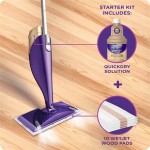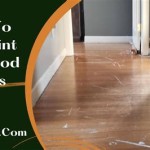How to Paint Wood Floors: A Comprehensive Guide
Painting wood floors offers a cost-effective way to revitalize a room, conceal imperfections, and achieve a desired aesthetic without the expense of replacement. While the process requires careful preparation and precise execution, it is a manageable DIY project for homeowners with basic skills. This article provides a detailed guide on how to successfully paint wood floors, covering the necessary materials, preparation steps, painting techniques, and post-painting considerations.
The decision to paint wood floors should be carefully considered. Unlike staining, which allows the wood grain to remain visible, paint completely covers the floor's natural appearance. However, paint offers a wider range of color options and can effectively hide blemishes, dents, and uneven surfaces. Furthermore, painted floors can be easily adapted to evolving design preferences through repainting, providing flexibility in interior design.
Key Point 1: Preparing the Wood Floor for Painting
Proper preparation is the most critical aspect of painting wood floors. A poorly prepared surface will result in paint that chips, peels, or wears unevenly. The preparation process involves cleaning, sanding, and priming, each step contributing to the overall adhesion and durability of the paint finish.
Cleaning: Begin by thoroughly cleaning the floor to remove dirt, dust, grease, and any existing coatings. Use a vacuum cleaner with a brush attachment to remove loose debris from cracks and corners. Next, wash the floor with a wood cleaner specifically designed to remove grime and wax buildup. Avoid harsh chemicals that can damage the wood or interfere with paint adhesion. For stubborn stains or grease spots, use a degreasing cleaner following the manufacturer's instructions. Rinse the floor thoroughly with clean water and allow it to dry completely before proceeding to the next step.
Sanding: Sanding creates a textured surface that allows the paint to adhere properly. The extent of sanding required depends on the existing floor condition. If the floor has a glossy finish or multiple layers of old paint, a more aggressive sanding approach is necessary. For floors in relatively good condition, light sanding may suffice. Use a floor sander for large areas and an orbital sander for edges and corners. Start with a coarse-grit sandpaper (e.g., 60-80 grit) to remove the existing finish, then gradually move to finer grits (e.g., 100-120 grit, then 150-180 grit) to smooth the surface. Vacuum the sanding dust thoroughly between each grit change.
When sanding, pay attention to detail. Ensure the edges and corners are sanded evenly with the main floor area. Avoid gouging or damaging the wood. If the floor has deep scratches or imperfections, consider using wood filler to repair them before sanding. Follow the manufacturer's instructions for application and drying time. After sanding, vacuum the floor meticulously to remove all dust particles. Use a tack cloth to wipe the floor and remove any remaining fine dust. A clean, dust-free surface is essential for optimal paint adhesion.
Priming: Applying a primer is crucial for several reasons. Primer seals the wood, providing a uniform surface for the paint. It also enhances paint adhesion, prevents tannins from bleeding through the paint (especially with light-colored paints), and improves the paint's overall durability. Choose a high-quality oil-based or latex primer specifically designed for wood floors. Apply the primer evenly using a brush or roller, following the manufacturer's instructions. Allow the primer to dry completely before proceeding to the painting stage. Lightly sand the primed surface with fine-grit sandpaper (e.g., 220 grit) to create an even smoother surface for painting. Vacuum and wipe the floor with a tack cloth to remove any sanding dust.
Key Point 2: Selecting the Right Paint and Tools
The choice of paint and tools significantly impacts the final appearance and durability of the painted wood floor. Selecting appropriate materials ensures a professional-looking finish that withstands daily wear and tear.
Paint Type: For wood floors, the most suitable paint types are oil-based and water-based (latex) floor paints. Oil-based paints provide a durable, hard-wearing finish that resists scratches and scuffs. They also offer excellent adhesion and leveling properties, resulting in a smooth, even surface. However, oil-based paints have a longer drying time, emit strong odors, and require mineral spirits for cleanup. Water-based (latex) paints are a more environmentally friendly option. They dry quickly, have low odor, and are easy to clean up with water. However, latex paints may not be as durable as oil-based paints and may require multiple coats for optimal coverage. Consider using a latex paint specifically formulated for floors, which contains additives to enhance durability and abrasion resistance.
Paint Finish: The paint finish affects the appearance and maintenance of the floor. Gloss finishes are the most durable and easiest to clean, but they can highlight imperfections. Semi-gloss finishes offer a good balance of durability and ease of cleaning, with less glare than gloss finishes. Satin finishes provide a softer, more matte appearance but may be less resistant to scratches and stains. Matte finishes are the least durable and most difficult to clean but offer a contemporary, non-reflective look. Select a finish that aligns with individual aesthetic preferences and anticipated floor traffic.
Tools: Essential painting tools include paintbrushes, rollers, paint trays, painter's tape, and drop cloths. Use high-quality brushes with synthetic bristles for applying paint in corners and along edges. Choose a roller with a short nap (e.g., 1/4 inch or 3/8 inch) for applying paint to the main floor area. A short nap roller ensures a smooth, even finish without excess texture. Use painter's tape to protect baseboards, walls, and other trim from paint splatters. Apply the tape carefully, ensuring a tight seal to prevent paint bleed-through. Use drop cloths to protect furniture and other surfaces from paint spills and splatters.
Calculating the amount of paint required is crucial to avoid running out mid-project. Measure the square footage of the floor and consult the paint manufacturer's coverage guidelines. Typically, one gallon of paint covers approximately 350-400 square feet. However, coverage can vary depending on the paint type, color, and the condition of the floor. Purchase slightly more paint than estimated to account for variations in coverage and ensure sufficient material for touch-ups.
Key Point 3: Painting Techniques and Post-Painting Care
Applying the paint properly and implementing post-painting care procedures ensures a long-lasting and aesthetically pleasing finish.
Painting Process: Begin by applying painter's tape to the baseboards and trim to protect them from paint. Pour the paint into a paint tray and load the brush or roller evenly. Start painting along the edges of the room with a brush, creating a "cut-in" line. This involves painting a narrow strip along the perimeter of the floor, ensuring a clean, defined edge. Next, use the roller to apply paint to the main floor area. Work in small sections, overlapping each stroke slightly to avoid gaps and ensure even coverage. Maintain a wet edge to prevent visible seams. Apply the paint in thin, even coats, allowing each coat to dry completely before applying the next. Multiple thin coats are preferable to one thick coat, as they result in a more durable and uniform finish.
Allow the first coat of paint to dry completely according to the manufacturer's instructions. This typically takes several hours or overnight. Lightly sand the first coat with fine-grit sandpaper (e.g., 220 grit) to remove any imperfections and create a smooth surface for the second coat. Vacuum and wipe the floor with a tack cloth to remove any sanding dust. Apply the second coat of paint using the same techniques as the first coat. Ensure the second coat is applied evenly and completely covers the floor. Allow the second coat to dry completely before removing the painter's tape. Remove the tape carefully to avoid peeling off any paint.
Post-Painting Care: After the paint has dried completely, allow the floor to cure for several days before placing furniture or heavy objects on it. Curing allows the paint to fully harden and develop its maximum durability. Avoid walking on the floor with shoes during the curing period. Place felt pads under furniture legs to protect the painted surface from scratches and scuffs. Use area rugs in high-traffic areas to further protect the floor. Clean the painted floor regularly with a damp mop and a mild detergent. Avoid using harsh chemicals or abrasive cleaners, as they can damage the paint finish. Touch up any scratches or chips promptly to prevent further damage. With proper care and maintenance, a painted wood floor can provide years of beauty and functionality.
Addressing potential problems during and after the painting process is paramount for achieving a professional finish. Paint drips or sagging should be addressed immediately by smoothing them out with a brush or roller while the paint is still wet. If drips dry, they may require sanding before applying subsequent coats. Bubbling or blistering may indicate moisture problems or poor adhesion. Ensure the floor is completely dry before painting and use a high-quality primer to improve adhesion. If the paint peels or chips, the underlying surface was likely not properly prepared. Thoroughly sand, clean, and prime the affected area before repainting.

How To Paint Wood Floors Beautifully Last H2obungalow

How To Paint Wood Floors Without Sanding The Heathered Nest

How To Paint Wood Floors 5 Easy Steps B Vintage Style

How To Paint Hardwood Floors Addison S Wonderland

Paint For Wood Floors In The Flip House My Creative Days

Ultimate Wood Floor Paint Polyurethane Resin Based Everest Paints

Diy How To Paint Wood Floors Like A Pro Shabbyfufu Com

Painting An Antique Wood Floor Color Me Thrifty

How I Chalk Painted Wood Floors Hallstrom Home

How To Paint Wood Floors Everything You Need Know Maria Louise Design







